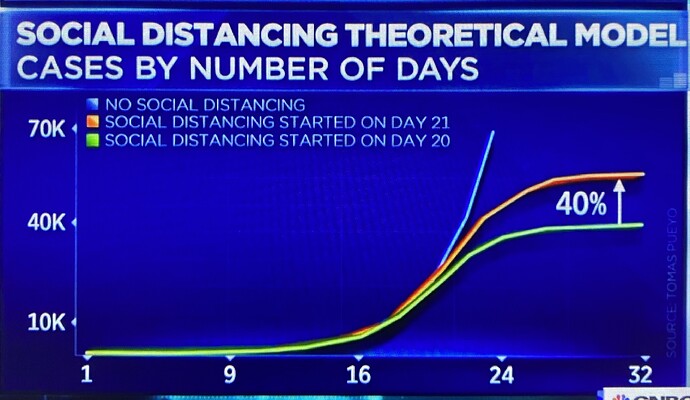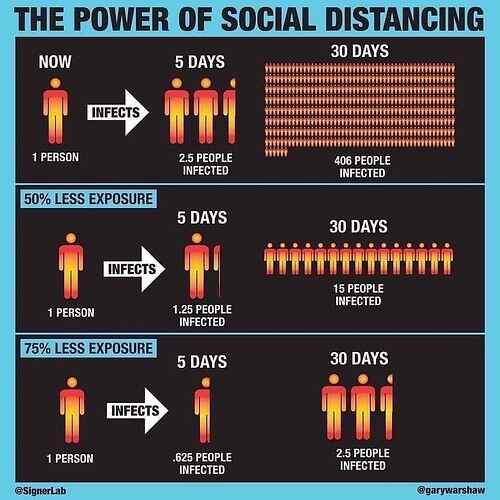Copied that and sharing. One of those picture/thousand word things. Thanks, kiddo.
This theoretical model points out that with extreme “social distancing”, we’ll greatly flatten out the virus case-load bell curve (exponential rise, exponential decay) of new infections. Meaning there may be fewer hospital overloads (due to combined hospitalizations for flu/covid-19). The tradeoff, however, is a more drawn-out period of new cases of covid-19 than otherwise. In other words, instead of this novel virus event possibly winding down at the end of April, social distancing will stretch it out, maybe into summer. Same total number of cases eventually, but fewer new cases per day. I think that the amount of damping (“social distancing” directives by governments) has been vastly excessive. And that it’s effecting irreparable damage to our culture and customs, and in many instances, I’m afraid, a death blow to some of our restaurants.
Good thing you’re not in charge and no public health professional agrees with you.
The UK’s on track to be a test case for not doing too much.
I’m a scientist, not a health professional, and I most definitely wouldn’t want to be in charge because I’m not qualified. But I have my opinions based on what I’ve read and the data I’ve seen, and so do you. I don’t want to get into a spat. Differing opinions are, at any given time, the nucleus for change of opinion; all are worth being heard.
I find it a help to look at this year’s flu season cases and deaths. I posted this link early on, in late February, but it keeps being updated:
PS. If in fact I were in charge I’d leave everything open – meaning restaurants included – and publish a list of precautionary steps for people to take to avoid getting The Virus. I would recommend that all who are infirm or weak from sedentary or degenerative age to try to keep distance from others, as with the flu and even colds. I would not shut down restaurants. I would not tell people to stay in their homes for gawd’s sake.
why do those stick figures look like bacon?
Obligatory gif

I’m guessing you saw that Jason Scott Warner piece of Medium. Powerful math.
Because ever since I mentioned the bacon bar…
![]()
Yes. But I often think exponentially, in that I am frequently explaining to people why a five cent increase in fuel costs or labor doesn’t mean that each one of us pays just five cents, I have to explain the effects on costs, exponentially, up and down supply chains.
In any case, I’m ranting
My husband has his undergrad degree in accounting and an MBA in finance. His favorite word is “compounding.” ![]() I used to work in parasitology at CDC and the test I ran every day had me dilute serum to 1:1024. So, yeah, we get it.
I used to work in parasitology at CDC and the test I ran every day had me dilute serum to 1:1024. So, yeah, we get it.
Yeah, that’s the math that DoctorChow is somehow missing.
That plus so much of the spread is hidden since such a high percentage of people have no symptoms. If half of those people are walking around with no symptoms, and half the people they infect have no symptoms, within a couple of months virtually the whole population has been exposed.
My niece was just told to get all of her stuff out of NYU dorms by the weekend. They are getting ready for potential use as makeshift hospital.
If all colleges are going online this might help the lack of hospital beds.
I understand exponentials quite well, thank you very much. Here’s the simple concept for any exponential: When the rate of change in the amount of something is proportional to the amount of that something itself at any given time, that’s an exponential rate of change. So yes, when the number of new cases per day (rate of change in amount) is proportional to the number of existing cases that day (amount), it’s an exponential growth.
The part that you’re missing is that, for viral infections like all of the previous pandemics and every year’s seasonal flu, the exponential growth doesn’t continue indefinitely. The rate of change slows, and then becomes negative, and the subsequent decline is also an exponential. That’s why “the curve” of new cases per day vs. time has a peak, and a bell shape, overall, and the total number of cases is an S-shaped curve that only goes up. It never comes down but asymptotes (flattens out, almost) eventually. Reducing the peak of the cases-vs-time curve is what people call “flattening” the curve (damping). By flattening the curve, all previous experience with viruses has shown that the overall cases/day curve is spread out over a longer period of time. The total eventual number of cases is about the same with or without damping. The flattened curve also has exponential growth and decay periods, but both are “softer” exponentials. The number of deaths will be reduced only if flattening the curve prevents hospital overload that prevents treatment of the very ill. The NYT article you just posted is correct in that, of course, but it’s a prediction: Notice the term “may not be”. Exponential spread of the virus won’t continue indefinitely, with or without damping. The real question is, how much damping is needed to prevent hospital overload? That’s the $64M question. Time will tell, but I think that closing down restaurants is way overdoing it.
Right. That’s the only reason for social distancing. Haven’t we all understood that already?
We don’t know. Due to the lack of testing we won’t for some time. Few people want to find out the hard way.
DR. ANTHONY FAUCI: … the golden rule that I say is that when you think you’re doing too much, you’re probably doing enough or not enough. All right, that’s the thing you’ve got to do. You don’t want to be complacent. You always want to be ahead of the curve. But it depends on how far ahead of the curve you want to be. Don’t even for a second think that I’m saying we shouldn’t – I like to be criticized. When I say, “Oh, you’re being too overreactive,” that’s good for me.
CHUCK TODD: Okay, right. Let me ask it this way. We’ve had a health care official say this to us. That if we could guarantee that people would get their sick leave pay, guarantee that we could basically do what FEMA does in a natural disaster, give people cash for the basics, for groceries, would you prefer a 14 day just sort of national shutdown to slow this?
DR. ANTHONY FAUCI: You know, I would prefer as much as we possibly could. I think we should really be overly aggressive and get criticized for overreacting.
Not overwhelm hospital capacity, decrease deaths and allow time for vaccine to be developed. A few elderly people may be saved if a few kids skip partying for a month or two. Who knows one of the elderly might be on the verge of a breakthrough in cancer research…
Btw I hear our healthcare professionals currently do not have sufficient protective gear.
#deadpeoplepilingupgenerallyfrownedupon
Exactly. We don’t know how much damping (“social distancing” in this case) is needed. It’s my opinion that we’re overdoing it – hitting a nail with a sledgehammer.
I’m not sure what you thought I didn’t understand about exponentials.
As to how many people will eventually be infected, the answer is probably a good percentage of the entire population, world-wide, regardless of what is done. I’ve seen estimates (educated guesses) between 30% and 80%. For most, hopefully, their symptoms will be mild or non-existent, and without complications like pneumonia.
Another question is, how many people were and are in hospitals around the world with flu? I haven’t seen any data for this, other than the CDC data (for the US) on the link I posted earlier (#67). The coincidence of the seasonal flu and this new virus is unfortunate, and is contributing to hospitals reaching capacity.
And thereby less ICU overload and less people die (interesting that you leave out the most important part)
I did say that, Honk, in a later post (#77, above). There, I pretty much repeated what I’d said in the post you quoted, but with more detail, because Robert thought I was missing something in “the math”. I’ve also made that point in other, previous posts elsewhere. (The discussion threads have been moving around.)

